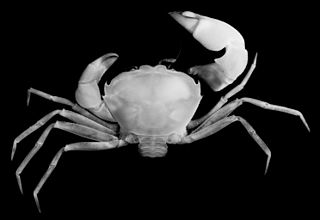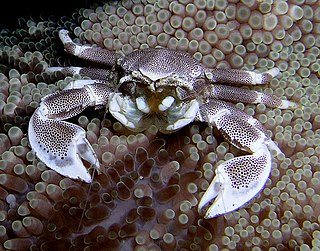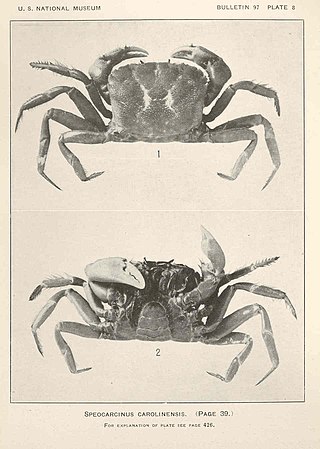
Anomura is a group of decapod crustaceans, including hermit crabs and others. Although the names of many anomurans include the word crab, all true crabs are in the sister group to the Anomura, the Brachyura.

Cancer is a genus of marine crabs in the family Cancridae. It includes eight extant species and three extinct species, including familiar crabs of the littoral zone, such as the European edible crab, the Jonah crab and the red rock crab. It is thought to have evolved from related genera in the Pacific Ocean in the Miocene.

Hymenosomatidae is a family of crabs with some 110 described species in 24 genera. The following genera are placed in the Hymenosomatidae:

Cancridae is a family of crabs. It comprises six extant genera, and ten exclusively fossil genera, in two subfamilies:
Hexapus is a genus of crabs in the family Hexapodidae. It contains only three extant species found in the Indo-West Pacific. They inhabit the intertidal and subtidal areas of shorelines.
Etyiidae is a prehistoric family of dromiacean crabs only known from Cretaceous and a few Paleocene fossils.

Dromiacea is a group of crabs, ranked as a section. It contains 240 extant and nearly 300 extinct species. Dromiacea is the most basal grouping of Brachyura crabs, diverging the earliest in the evolutionary history, around the Late Triassic or Early Jurassic. Below is a cladogram showing Dromiacea's placement within Brachyura:

Homolodromiidae is a family of crabs, the only family in the superfamily Homolodromioidea. In contrast to other crabs, including the closely related Homolidae, there is no strong linea homolica along which the exoskeleton breaks open during ecdysis. The family comprises two genera, Dicranodromia, which has 18 species, and Homolodromia, with five species.

Carpilioidea is a superfamily of crabs containing a single extant family, Carpiliidae and three extinct families. The modern range of the family includes the Indo-Pacific, Western Atlantic and Caribbean Sea. The fossil record of the group extends back at least as far as the Paleocene.

Goneplacidae is a family of crabs of the order Decapoda and the superfamily Goneplacoidea. It includes the following genera:

Eubrachyura is a group of decapod crustaceans comprising the more derived crabs. It is divided into two subsections, based on the position of the genital openings in the two sexes. In the Heterotremata, the openings are on the legs in the males, but on the sternum in females, while in the Thoracotremata, the openings are on the sternum in both sexes. This contrasts with the situation in other decapods, in which the genital openings are always on the legs. Heterotremata is the larger of the two groups, containing the species-rich superfamilies Xanthoidea and Pilumnoidea and all the freshwater crabs. The eubrachyura is well known for actively and constantly building its own burrows. The fossil record of the Eubrachyura extends back to the Cretaceous; the supposed Bathonian representative of the group, Hebertides jurassica, ultimately turned out to be Cenozoic in age.

Metacarcinus is a genus of crabs formerly included in the genus Cancer. It includes nine exclusively fossil species and five extant species, of which four are also known from the fossil record. A molecular study using the cytochrome oxidase I gene does not support the monophyly of this genus.

Corystidae is a family of crabs, in its own superfamily, Corystoidea. It includes what was once thought to be the oldest Eubrachyuran fossil, Hebertides jurassica, thought to be dating from the Bathonian ; the species was subsequently reinterpreted as being Cenozoic in age. Corystidae contains ten extant and five extinct species in eight genera:

Cheiragonidae is a small family of crabs, sometimes called helmet crabs, placed in its own superfamily, Cheriagonoidea. It comprises three extant species, Erimacrus isenbeckii, Telmessus acutidens and Telmessus cheiragonus, there are no yet evidences of Cheiragonidae in the fossil record. Many of these crabs were formerly treated as members of the Atelecyclidae.

Pilumnoidea is a superfamily of crabs, whose members were previously included in the Xanthoidea. The three families are unified by the free articulation of all the segments of the male crab's abdomen and by the form of the gonopods. The earliest fossils assigned to this group are of Eocene age.

Matutidae is a family of crabs, sometimes called moon crabs, adapted for swimming or digging. They differ from the swimming crabs of the family Portunidae in that all five pairs of legs are flattened, rather than just the last pair, as in Portunidae. Crabs in the Matutidae are aggressive predators.

Pseudozioidea is a superfamily of crabs, formerly treated in the Eriphioidea, Carpilioidea, Xanthoidea, Pilumnoidea and Goneplacoidea. A number of fossils from the Eocene onwards are known from the family Pseudoziidae. Eleven genera are recognised in three families:

The Galatheoidea are a superfamily of decapod crustaceans comprising the porcelain crabs and some squat lobsters. Squat lobsters within the three families of the superfamily Chirostyloidea are not closely related to the squat lobsters within the Galatheoidea. The fossil record of the superfamily extends back to the Middle Jurassic genus Palaeomunidopsis.

Polydectus cupulifer is a species of crab in the family Xanthidae, and the only species in the genus Polydectus. Together with the genus Lybia, it forms the subfamily Polydectinae. It is found in the Indo-Pacific, ranging from Madagascar and the Red Sea in the west to Japan, Hawaii and French Polynesia in the east. P. cupulifer is densely covered with setae (bristles), and frequently carries a sea anemone in each chela (claw).

Speocarcinus is a genus of crabs in the family Xanthidae, containing six extant species, one fossil species from the Late Miocene, one fossil species from the Eocene (Lutetian) and one fossil species from the Early Eocene (Ypresian):


















